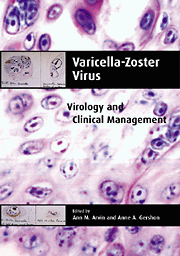Preface
Published online by Cambridge University Press: 02 March 2010
Summary
Major milestones in the understanding of varicella-zoster virus (VZV) occurred in the eighteenth century when varicella was recognized to be distinct from smallpox, and in the mid-twentieth century Weller and colleagues first succeeded in isolating the virus in cell culture. Nevertheless, as recently as 30 years ago only a handful of virologists were pursuing research on VZV, mainly because the diseases it caused were perceived as minor and it proved to be extremely difficult to propagate the virus in the laboratory. There were several achievements, however, that resulted in a veritable explosion in research on this pathogen, beginning in the early 1970s. First was development of a live attenuated varicella vaccine by Takahashi and colleagues. Other significant new interventions were introduced almost simultaneously, including passive immunization and antiviral therapy, along with the realization that diseases caused by VZV are not necessarily benign, especially in developed nations with aging populations and increasing numbers of immunocompromised patients. Next came the availability of molecular techniques, permitting bypass of propagation of the virus for its study, and allowing mutation of viral genes within the virus, leading to elucidation of the processes of VZV gene expression, latency, viral pathogenesis and immune responses. Finally the organization of the Varicella-Zoster Research Foundation by Richard Perkin led to improved communication between basic and clinical investigators studying VZV. In the brief period of about 10 years, this Foundation has hosted four international meetings on VZV, produced three volumes of Proceedings, presented four awards to premier senior scientists involved with VZV, and supported seven research fellowships for young investigators interested in VZV.
- Type
- Chapter
- Information
- Varicella-Zoster VirusVirology and Clinical Management, pp. xiii - xivPublisher: Cambridge University PressPrint publication year: 2000



